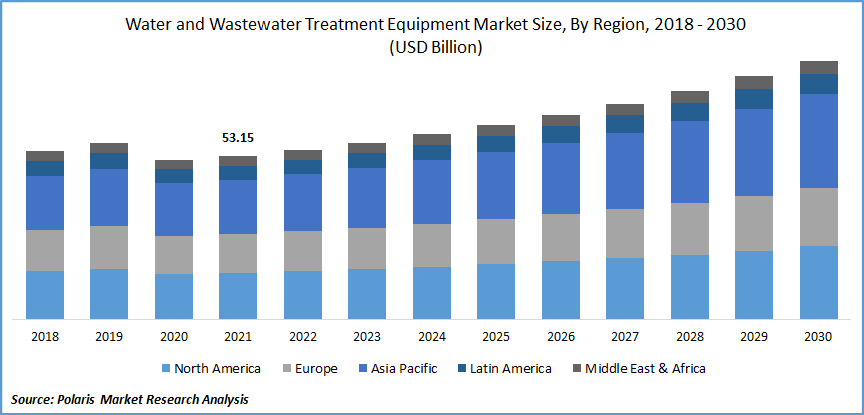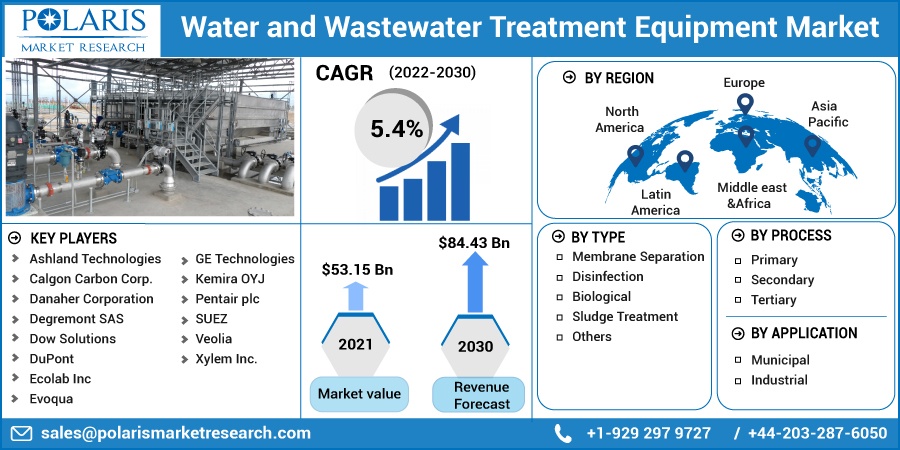
Water and Wastewater Treatment Equipment Market Share, Size, Trends, Industry Analysis Report, By Type (Membrane Separation, Disinfection, Biological, Sludge Treatment, Others); By Process; By Application; By Region; Segment Forecast, 2022 - 2030
- Published Date:Jun-2022
- Pages: 114
- Format: PDF
- Report ID: PM2476
- Base Year: 2021
- Historical Data: 2018-2020
Report Outlook
The global water and wastewater treatment equipment market was valued at USD 53.15 billion in 2021 and is expected to grow at a CAGR of 5.4% during the forecast period. H2O treatment is the method wherein the contaminated H2O is treated and made reusable for several purposes such as drinking, irrigation, and industrial applications. This procedure eliminates unsought toxins and lowers the risk of adverse health effects.
The research study provides a comprehensive analysis of the industry, assessing the market on the basis of various segments and sub-segments. It sheds light on the competitive landscape and introduces water and wastewater treatment equipment market key players from the perspective of market share, concentration ratio, etc. The study is a vital resource for understanding the growth drivers, opportunities, and challenges in the industry.
 Know more about this report: Request for sample pages
Know more about this report: Request for sample pages
Moreover, the effluent treatment equipment further helps in reducing the contaminations and lessens the impacts on the environment in case of disposal. The effluent H2O from households and SMEs are treated in several sewage plants by the municipal sources and is disposed to infiltration basins, evaporation ponds, and injection wells.
Further, there is a substantial rise in demand for clean H2O due to rising urbanization and industrialization. Increasing ecological and environmental concerns and stringent government rules, along with rising demand for the industry globally, are the factors driving the growth of the wastewater treatment equipment market. Likewise, rising investments in H2O treatment equipment services are also expected to drive the industry growth.
The outbreak of the COVID-19 pandemic has significantly impacted the growth of the wastewater treatment equipment market. There has been a negative impact on the wastewater treatment and sanitation market during COVID-19. This is due to the disruption of the supply chain during the pandemic that resulted in the scarcity of equipment and consumables that are used for such management procedures.
Furthermore, due to the lockdown and closure of industrial and commercial sectors, the effluent significantly lowered from such industries, which resulted in improved H2O quality levels and thereby reduced the volume of cleaning needed in H2O sources.
Globally, massive quantities of effluent are used without proper cleaning or inadequate cleaning leads to damaging the environment and causing major health hazards to humans. Non-treated effluents are the main carriers of spreading diseases. Therefore, in poor sanitization areas, the wide spread of coronavirus diseases is also a threat worldwide.
 Know more about this report: Request for sample pages
Know more about this report: Request for sample pages
Industry Dynamics
Growth Drivers
The increase in demand for clean and treated H2O has enhanced due to an increase in rapid urbanization, technological advancements, rising population, and infrastructure expansion worldwide. However, due to limited treated or fresh H2O, there is an increasing emphasis on effluent cleaning and reusable H2O to fulfill the rising demand for wastewater cleaning machinery. Therefore, resulting in the growth of the wastewater treatment equipment market during the forecast period.
The global wastewater machinery market has further witnessed the advancement of advanced components such as filters and membranes that offers superior functional efficiency and also function for a longer duration. Moreover, increasing demand for clean and fresh H2O from refineries and the development of advanced components to treat wastes in oil & gas and manufacturing businesses are likely to drive the industry during the forecast period. Further, there have been stringent regulations by several government authorities regarding effluent expulsion from the industrial and municipal sectors, which would in turn stimulate the rise of such H2O cleaning equipment in the future.
Report Segmentation
The market is primarily segmented based on type, process, application, and region.
|
By Type |
By Process |
By Application |
By Region |
|
|
|
|
Know more about this report: Request for sample pages
Membrane Separation Type Accounted for the Largest Market in 2021
Membrane separation is a substantial and primary method for treatment wherein high-pressure feed is passed through a semi-permeable membrane that removes harsh substances from the solution. This type of H2O cleaning equipment type has numerous benefits over other methods, such as high filtration efficiency and compact operating area, among others.
The biological treatment method is generally a secondary procedure for removing the remaining contaminants after the membrane separation method of cleaning. Various developed countries such as the U.S., Canada, Japan, and Germany are likely to enhance the necessity for biological cleaning equipment by imposing stringent regulations for minimizing H2O pollution in the manufacturing sectors by using such eco-friendly methods.
The sludge segment includes screening, sludge drying, and thickening. This sludge screening equipment is utilized to eliminate solids, such as plastics, fibers, and hair, which in turn helps in preventing the disruption of consequent sludge cleaning processes.
Tertiary Treatment Process Accounted for the Largest Market Share in 2021
Based on the process, the tertiary method is projected to be the largest segment in the water and wastewater treatment equipment market. The segment is expected to account for over 40% of the global revenue. The tertiary wastewater cleaning process is used to improve emission-quality before reusing the H2O and discharging the same in the ecosystem. In the tertiary process, effluent is reused by removing inorganic elements such as viruses, bacteria, and parasites, and therefore, making the H2O ideal for reuse.
Similarly, the primary wastewater cleaning process is utilized for separating moving materials and dense solids from sewage. Wherein effluent is passed through various filters that separate H2O from toxins. Factors such as low operating costs are likely to increase the adoption of primary cleaning.
Municipal Sector is Expected to Hold the Significant Revenue Share
The municipal application segment is expected to be the largest segment in the wastewater treatment equipment market and will account for more than 50% share of the global revenue in 2021. This is due to the increasing population, along with beneficial government strategies and guidelines that are mainly dedicated to encouraging infrastructure development. Therefore, it is likely to increase the demand for H2O cleaning equipment in the municipal sectors.
Municipal services are predominantly used to safeguard H2O reserves and organic aquatic techniques by removing Effluent Organic Matter (EfOM), pathogens, and nutrients from effluent. Moreover, increasing awareness concerning effluent methods and increased involvement of governments in improving H2O cleaning equipment infrastructure around the globe are anticipated to boost the segment growth during the forecast period.
Asia-Pacific Region Lead the Global Water and Wastewater Treatment Equipment Market by 2030
The Asia-Pacific region accounted for the largest market share in 2021. The improvement in various socio-economic factors in the Asia Pacific and LAMEA regions is anticipated to increase the demand for H2O cleaning equipment. Additionally, several technological advancements linked with investment in purification plants have boosted the market growth of Asia-Pacific countries.
Further, the speedily growing manufacturing sector, along with industries with increased investment in effluent management, results in the growth of this market in Asia-Pacific. Moreover, the growing population and increasing residential sector in the Asia-Pacific region are anticipated to grow the product application in municipal H2O treatment plants.
Competitive Insight
Some of the major players operating in the global wastewater treatment equipment market include Ashland Technologies, Aquatech International LLC Technologies, Calgon Carbon Corp., Danaher Corporation, Degremont SAS, Dow Solutions, DuPont, Ecolab Inc, Evoqua, GE Technologies, Kemira OYJ, Pentair plc, SUEZ, Veolia, and Xylem Inc.
Recent Developments
- In March 2021, Xylem Inc., extended its emphasis on smart H2O technology to focus on H2O shortage and operational costs concerns. The company Xylem Inc. intends to acquire several smart H2O companies and also intends in making R&D investments.
- Further, Danaher Corporation has made substantial investments in industrial capital punishment and innovation, which will aid them in gaining market presence in the wastewater treatment equipment market. The company is also intending to expand its product portfolio with surging development for delivering long-term and sustainable investor value.
Water and Wastewater Treatment Equipment Market Report Scope
|
Report Attributes |
Details |
|
Market size value in 2021 |
USD 53.15 billion |
|
Revenue forecast in 2030 |
USD 84.43 billion |
|
CAGR |
5.4% from 2022 - 2030 |
|
Base year |
2021 |
|
Historical data |
2018 - 2020 |
|
Forecast period |
2022 - 2030 |
|
Quantitative units |
Revenue in USD billion and CAGR from 2022 to 2030 |
|
Segments covered |
By Type, By Process, By Application, By Region |
|
Regional scope |
North America, Europe, Asia Pacific, Latin America, Middle East & Africa |
|
Key companies |
Ashland Technologies, Aquatech International LLC Technologies, Calgon Carbon Corp., Danaher Corporation, Degremont SAS, Dow Solutions, DuPont, Ecolab Inc, Evoqua, GE Technologies, Kemira OYJ, Pentair plc, SUEZ, Veolia, Xylem Inc. |
In today’s hyper-connected world, running a business around the clock is no longer an option. And at Polaris Market Research, we get that. Our sales & analyst team is available 24x5 to assist you. Get all your queries and questions answered about the water and wastewater treatment equipment market report with a phone call or email, as and when needed.
